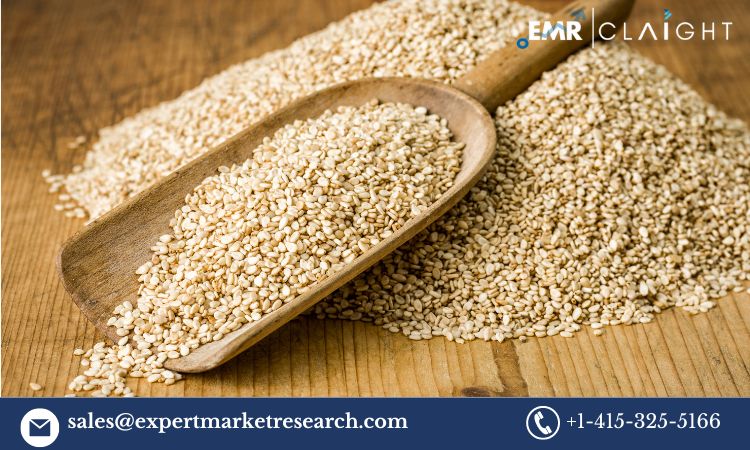
Sesame seeds are one of the most nutrient-rich oilseeds used across various industries, including food, pharmaceuticals, cosmetics, and agriculture. These small yet powerful seeds offer high nutritional value, with benefits such as rich antioxidants, heart-healthy fats, and essential minerals. Their increasing demand is fueled by growing consumer awareness of health benefits, expanding applications in food processing, and advancements in sesame seed hybrid development.
The global sesame seeds market size is projected to grow at a CAGR of 2.3% from 2025 to 2034, driven by rising consumption of healthy foods, growing demand for plant-based proteins, and advancements in sustainable sesame cultivation.
This blog explores the market dynamics, key drivers, challenges, trends, and future opportunities shaping the global sesame seeds industry.
Market Overview
Sesame seeds are widely cultivated across Asia, Africa, and South America, serving as a key ingredient in traditional cuisines, bakery products, confectionery, and oil production. The growing demand for natural and organic food products is driving sesame seed consumption across the food and beverage, cosmetic, and pharmaceutical sectors.
Major Types of Sesame Seeds
- White Sesame Seeds – Used in baking, salads, and tahini production.
- Black Sesame Seeds – Preferred for medicinal uses, premium snacks, and high-antioxidant content.
- Brown Sesame Seeds – Primarily used in oil extraction and culinary applications.
- Hulled Sesame Seeds – Refined for paste production, confectionery, and health supplements.
Sesame is also resistant to drought and pests, making it a sustainable crop with high market potential.
Key Market Drivers
Several factors are driving the global sesame seeds market growth:
1. Rising Consumer Awareness of Health Benefits
Sesame seeds are rich in fiber, protein, calcium, iron, and omega-6 fatty acids, making them a superfood in plant-based diets. Consumers are increasingly incorporating sesame seeds into salads, smoothies, and organic snacks.
2. Growing Demand for Plant-Based and Functional Foods
The shift towards vegan and vegetarian diets has boosted demand for plant-based protein sources, including sesame seed-based dairy alternatives, tahini, and sesame protein powders.
3. Expanding Applications in the Food and Beverage Industry
Sesame seeds are widely used in bakery products, condiments, snacks, and sauces. Popular food items such as hamburger buns, sushi rolls, and energy bars incorporate sesame for both taste and nutrition.
4. Increasing Use of Sesame Oil in Cosmetics and Pharmaceuticals
Sesame oil contains antibacterial and anti-inflammatory properties, making it a preferred ingredient in skincare, massage oils, and medicinal formulations. The demand for organic and natural beauty products has further fueled its growth.
5. Advancements in Sesame Seed Cultivation and Hybrid Varieties
Innovations in high-yield sesame seed varieties and drought-resistant cultivation techniques are helping farmers enhance productivity and profitability.
6. Growing Demand for Ethnic and Traditional Foods
Sesame seeds are an integral part of Asian, Middle Eastern, and Mediterranean cuisines. The rising popularity of ethnic flavors and plant-based diets is increasing sesame consumption worldwide.
7. Expansion of Organic and Non-GMO Sesame Seed Production
Consumers are demanding chemical-free, non-GMO, and organic sesame seeds, leading to higher adoption of sustainable farming methods.
Market Challenges
Despite its growth potential, the sesame seeds market faces several challenges:
1. Fluctuations in Climate and Weather Conditions
Sesame crops are highly sensitive to extreme weather, including drought, excessive rainfall, and temperature fluctuations, which can impact yields and supply stability.
2. Price Volatility Due to Supply Chain Disruptions
The sesame market is affected by fluctuations in global supply and demand, leading to price instability and challenges in raw material sourcing.
3. Risk of Contamination and Quality Control Issues
Strict food safety regulations require sesame seed producers to maintain high standards in processing, storage, and export quality. Contamination risks, such as salmonella outbreaks, pose challenges for suppliers.
4. Competition from Alternative Plant-Based Ingredients
While sesame seeds are widely used in food and cosmetics, competing seeds such as flaxseed, chia seeds, and hemp seeds provide alternative sources of nutrition and oil.
5. Trade Restrictions and Export Barriers
Some countries impose strict trade policies, tariffs, and import regulations on sesame seed exports, impacting global trade flows.
Key Market Trends
Several emerging trends are shaping the global sesame seeds industry:
1. Growth of Sustainable and Regenerative Agriculture
Farmers are adopting organic farming, crop rotation, and sustainable irrigation methods to enhance sesame yields while reducing environmental impact.
2. Expansion of Sesame-Based Dairy Alternatives
With the rise of dairy-free products, sesame seed milk and sesame-based cheese alternatives are gaining popularity.
3. Increased Demand for Functional and Fortified Sesame Products
Manufacturers are launching sesame-enriched protein powders, supplements, and fortified foods targeting health-conscious consumers.
4. Technological Advancements in Sesame Seed Processing
The use of automated sorting, hulling, and cold-press oil extraction is improving efficiency, quality, and shelf life.
5. Integration of Sesame Seeds in the Sports Nutrition Market
Sesame seeds are high in protein and essential minerals, making them a key ingredient in energy bars, protein shakes, and sports recovery products.
6. Rising Popularity of Sesame-Based Condiments and Sauces
Products like tahini, sesame oil dressings, and spicy sesame pastes are becoming staple pantry items in international markets.
7. Expansion of E-Commerce and Direct-to-Consumer Sales
Online grocery platforms are boosting sesame seed sales through subscription services, organic brands, and specialty seed blends.




Leave a Reply